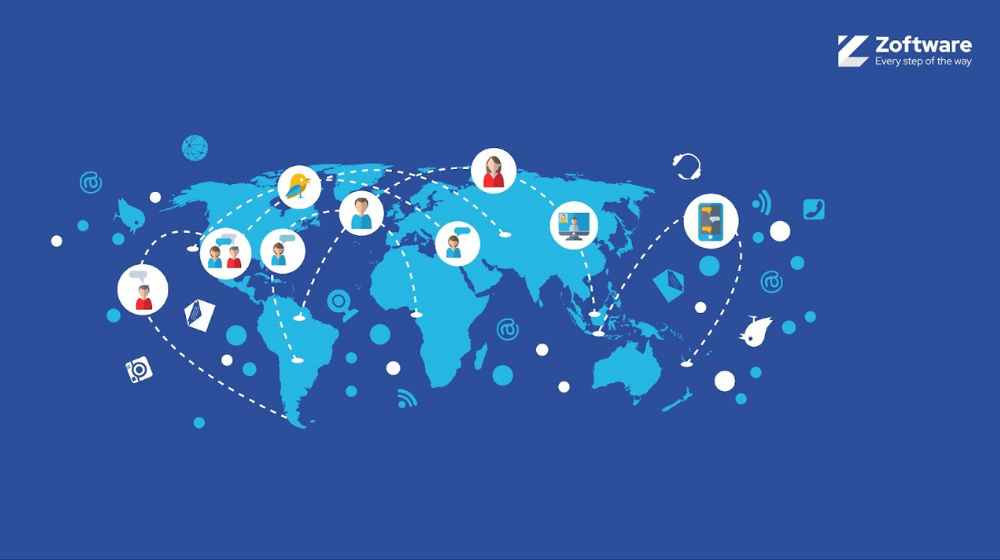The software-as-a-service (SaaS) industry is booming globally, and the Middle East is no exception. The market is expected to grow at a compound annual growth rate (CAGR) of 18.25% from 2023 to 2030, reaching a value of $22.7 billion by 2030.
Several factors drive this growth, including the increasing adoption of cloud computing, the growing demand for mobile applications, and the rising number of small and medium-sized businesses in the region.
The SaaS market in the Middle East is still in its early stages of development, but there are several prominent international players already operating in the region, such as Salesforce, SAP, and Oracle. However, there are also a growing number of local SaaS companies that are gaining traction.
One of the critical challenges facing businesses in the Middle East is choosing between local and international SaaS solutions. There are many factors to consider when making this decision, such as the cost of the solution, the level of support available, and the cultural fit.
Local SaaS solutions are often more affordable and can provide better support for local languages and regulations. However, international SaaS solutions may offer broader features and functionality.
The best way to choose between local and international SaaS solutions is to consider your specific needs and requirements carefully. If you are unsure, consulting with a technology expert is always best.
SaaS in the Middle East: A Historical Context
The technology and SaaS landscape in the Middle East has changed dramatically over the past decade. In the early 2010s, the region largely relied on traditional on-premises software solutions. However, the rapid growth of internet penetration and cloud computing has led to a growing adoption of SaaS solutions.
This shift has been driven by many factors, including:
- The increasing cost of maintaining and upgrading on-premises software.
- The need for businesses to be more agile and responsive to change.
- The growing demand for cloud-based applications that can be accessed from anywhere.
As a result of this shift, the Middle East is now one of the fastest-growing regions for SaaS adoption. The market is expected to reach $22.7 billion by 2030, growing at a CAGR of 18.25%.
The preference for local vs. international SaaS solutions has also evolved over time. In the early days, businesses in the Middle East were more likely to choose local solutions, as they were considered more reliable and secure. However, the growing quality and availability of international SaaS solutions has led to a shift in preference.
Today, businesses in the Middle East are increasingly choosing international SaaS solutions, as they offer a more comprehensive range of features and functionality and better scalability and flexibility. However, local SaaS solutions still have a role to play, particularly for businesses that must comply with local regulations or require support for local languages.
Here are some of the factors that have influenced the preference for local vs. international SaaS solutions in the Middle East:
- Cost: Local SaaS solutions are often more affordable than international solutions.
- Support: Local SaaS providers can often better support local languages and regulations.
- Scalability: Local SaaS solutions may be more scalable for businesses with small or medium-sized operations.
- Security: Local SaaS providers may be more familiar with local security requirements.
- Culture: Local SaaS solutions may be more culturally appropriate for businesses in the Middle East.
Ultimately, the best way to choose between local and international SaaS solutions is to consider your specific needs and requirements carefully. If you are unsure, consulting with a technology expert is always best.
Advantages of Local SaaS Solutions
In the Middle East, local SaaS solutions have distinct advantages that cater directly to regional businesses.
- Catered to local business needs and culture: Local SaaS solutions are designed to meet the specific needs of businesses in the Middle East. This includes factors such as the local language, currency, and regulations. For example, a local payroll SaaS solution will be able to handle the complexities of payroll in the Middle East, such as the different labor laws and tax rates.
- Local support and a better understanding of regional challenges: Local SaaS providers better understand the challenges faced by businesses in the Middle East. This includes factors such as the limited availability of internet bandwidth, the high cost of IT infrastructure, and the need to comply with local regulations. As a result, local SaaS providers can offer better support and more tailored solutions to regional businesses.
- Data sovereignty and regulatory compliance: Local SaaS solutions can help businesses to comply with local data protection regulations. This is important for companies that collect or process sensitive customer or employee data. For example, a local CRM SaaS solution can help businesses comply with the General Data Protection Regulation (GDPR).
Overall, local SaaS solutions offer many advantages for businesses in the Middle East. If you are considering adopting a SaaS solution, weighing the advantages and disadvantages of local and international solutions to find the best fit for your business is essential.
Advantages of International SaaS Solutions
International SaaS solutions have become a cornerstone for many businesses worldwide and for good reasons. The advantages of international SaaS solutions, with a focus on the following:
- Established reputation and trust: International SaaS providers have an established reputation and trust in the market. They have been around longer and have a proven track record of delivering reliable and secure solutions.
- Advanced features and integrations: International SaaS providers have larger R&D budgets than local providers, which allows them to develop more advanced features and integrations. This can be a significant advantage for businesses needing a wide range of functionality or integrating their SaaS solutions with other systems.
- Global support networks and infrastructure: International SaaS providers have global support networks and infrastructure. This means that businesses can get support 24/7, regardless of their location. They also have the infrastructure in place to support many users, which is vital for companies with a global reach.
In a nutshell, the global SaaS adoption trend is not just a fad. It’s driven by genuine advantages that these trusted SaaS platforms provide, from robust features to worldwide support, making them a compelling choice for businesses aiming for global competitiveness.
SaaS in Middle East: Challenges faced by SaaS Providers
The Middle East offers vast opportunities for SaaS providers with its vibrant business landscape and rapid digital transformation. However, entering and thriving in this market comes with its unique challenges.
- Localization and cultural adaptation: The Middle East has diverse cultures and languages. This can pose a challenge for SaaS providers who want to localize their products and services to meet the needs of local customers. They need to ensure that their products and services are translated into the local languages and that they take into account the cultural nuances of the region.
- Currency and payment barriers: The Middle East has several different currencies. This can challenge SaaS providers who want to accept payments from customers in other countries. They need to find a way to process payments in a way that is convenient and affordable for their customers.
- Data sovereignty and GDPR implications: The Middle East has many different data sovereignty laws. It means that SaaS providers must be careful where they store their customers’ data. They also need to be aware of the GDPR, a European regulation that applies to businesses that process the personal data of EU citizens.
Here are some additional challenges faced by SaaS providers in the Middle East:
- Limited Internet bandwidth: The availability of internet bandwidth in the Middle East can be limited, impacting the performance of SaaS applications.
- High cost of IT infrastructure: The price of IT infrastructure in the Middle East can be increased, making it difficult for businesses to afford SaaS solutions.
- Lack of skilled IT professionals: There is a shortage of skilled IT professionals in the Middle East, making it difficult for businesses to implement and manage SaaS solutions.
In conclusion, while the Middle East offers vast potential for SaaS providers, understanding and addressing the distinct SaaS challenges in the Middle East is crucial for long-term success and sustainable growth.
Current Trends and Predictions
The SaaS market in the Middle East is growing rapidly and is expected to reach $22.7 billion by 2030. Several factors drive this growth, including the increasing adoption of cloud computing, the growing demand for mobile applications, and the rising number of small and medium-sized businesses in the region.
The following trends characterize the current market dynamics in the Middle East SaaS market:
- The increasing adoption of cloud computing: Cloud computing is becoming increasingly popular in the Middle East as businesses look for ways to reduce IT costs and improve agility.
- The growing demand for mobile applications: Mobile applications are becoming increasingly popular in the Middle East as more and more people own smartphones and tablets.
- The rising number of small and medium-sized businesses: The number of small and medium-sized enterprises (SMBs) in the Middle East is growing rapidly, and these businesses are increasingly looking for SaaS solutions to help them improve their operations.
The potential shift in preference for SaaS solutions in the Middle East based on economic, political, or technological factors is difficult to predict. However, it is possible that the following factors could influence the market in the future:
- Economic factors: The economic situation in the Middle East is volatile, which could impact the adoption of SaaS solutions. For example, businesses may be more reluctant to invest in new software solutions if the economy takes a downturn.
- Political factors: The political situation in the Middle East is also volatile, which could impact the adoption of SaaS solutions. For example, if there is a political crisis, businesses may be more concerned about security and less likely to adopt cloud-based solutions.
- Technological factors: Technological innovation is rapid, which could also impact the adoption of SaaS solutions. For example, new technologies like artificial intelligence and machine learning could create new opportunities for SaaS providers.
Zoftware Hub is the Middle East’s first and biggest software discovery platform. It helps businesses find the right software solutions for their needs and provides information about the latest trends in the SaaS market. If you are looking for a SaaS solution for your business, Zoftware Hub is a great place to start your search.
Zoftware serves as compasses, guiding companies through the vast sea of software choices, ensuring they align with the latest Middle East SaaS trends and future predictions.
Conclusion
The SaaS landscape in the Middle East is a dynamic tapestry of global and local influences, economic strategies, and technological leaps. Understanding the currents and forthcoming predictions for the Middle East SaaS industry is paramount to navigating this terrain. Platforms like Zoftware Hub are poised to lead this charge, ensuring businesses remain innovative and relevant in this evolving digital saga.
Ready to harness the future of SaaS in the Middle East? Dive into the vast repository of solutions at Zoftware Hub and elevate your business operations. Your next digital ally awaits!


